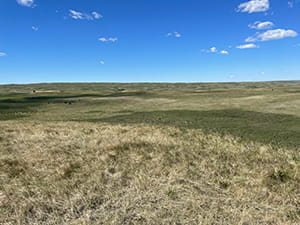By Kaitlin Burns, MSc, AAg, Agri-Environmental Specialist, Moose Jaw
April 2024
Native grasses refer to grass species that are indigenous to this region and have adapted to the province's climate, soil conditions and ecological communities without human intervention. Examples include blue grama grass, western wheatgrass and needle-and-thread grass.

Native grasses provide several benefits to agricultural producers:
- Grasslands are well-suited to grazing and require minimal inputs.;
- Native grasslands support diverse plant and animal species, enhancing ecosystem biodiversity and providing valuable habitat.
- Native grasses have deep root systems that improve soil structure, increase organic matter and enhance water infiltration.
- Native plant species are well-adapted to Saskatchewan's variable climatic conditions, contributing to environmental resiliency.
- Native plant species have deep root systems that sequester carbon dioxide from the atmosphere.
- Native plant species can provide high-quality forage for grazing animals.
While there are benefits to seeding native plant species, there are some challenges and limitations to consider prior to seeding. Sourcing quality native grass seed can be difficult. Native grass seed often comes at a higher cost compared to tame grass alternatives, which increases the financial investment required. Native grass stands typically have a higher level of seed dormancy compared to tame grass species, therefore, they require a longer establishment period.
To seed native grasses, ensure the native grass species are adapted to the soil texture, soil zone and environmental conditions. If possible, procure native forage seed from local suppliers to ensure adaptation to regional conditions. Ensure the native forage seed meets common #1 or certified #1 seed grade standards to prevent the introduction of noxious or invasive weeds into the forage stand. Sow seeds into a firm, weed-free seed bed and use effective weed control until the stand is established. Choose drill seeding over broadcast seeding to maximize seed-to-soil contact.
Under the Resilient Agricultural Landscapes Program (RALP), there is cost-share funding available for producers who would like to seed native forages. To learn more about the Seeding Native Forages Beneficial Management Practice (BMP), call the Agriculture Knowledge Centre at 1-866-457-2377 to speak with your local agri-environmental specialist.
